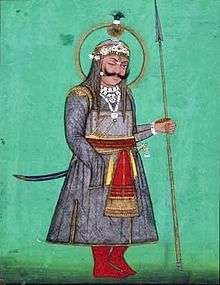Battle of Gagron
| Battle of Gagron | |||||||||
|---|---|---|---|---|---|---|---|---|---|
| Part of Rajput-Malwa Sultanate wars | |||||||||
 Rana Sanga Leader of the Rajput Confederation | |||||||||
| |||||||||
| Belligerents | |||||||||
|
|
Malwa Sultanate Gujarat Sultanate | ||||||||
| Commanders and leaders | |||||||||
|
Rana Sanga Rao Viramdeva Medini Rai |
Mahmud Khilji II (POW) Asaf Khan | ||||||||
Medini Rai was granted a fief by Rana Sanga. The Malwa Sultan encroached on it. To teach him a lesson, Rana Sanga marched against the Sultan. in the ensuing battle, the Muslim army was completely routed and Mahmud was taken prisoner. Rana Sanga treated him with honour and restored him his kingdom.
Battle
Rana Sanga advanced with a large army from Chittor reinforced by the Rathors of Merta under Rao Viramdeva, and met Sultan Mahmud Khilji II, accompanied by the Gujarat auxiliaries under Asaf Khan. As soon as the battle started the Rajput Cavalry made a fierce charge and tore through the Gujarat Cavalry, the few remnants that survived fled in every direction that they could find. The Rajput cavalry after routing the Gujarat reinforcements turned towards the Malwa army. The Sultan's forces fought bravely but could not withstand the furious charge of the Rajput cavalry and sustained a complete defeat. Most of his officers were killed and the army was nearly annihilated. Asaf Khan's son was killed, and Asaf Khan himself sought safety in flight. Sultan Mahmud was taken prisoner, wounded and bleeding.[2]
Aftermath
Rana Sanga treated the Sultan with honour and restored him his kingdom but as a mark of subjection, the Sultan yielded to the Maharana as nazrana the jewelled crown and belt left as a family heirloom by Sultan Hoshang Shah, the first king of Malwa. The Maharana also kept at Chittor a son of the Sultan as hostage for his future good conduct.
"It is difficult to characterize this clemency of the Maharana as a piece of sound policy. though the historean Abul Fazal gives unstinted praise to the Maharana, and Nizam-Ud-din Ahmed, the bigoted author of Tabqati Akbari, extols this act as an act of unprecedented munificence and magnamity, yet judged by its political results, the act has proved injurious to the national cause of the Rajputs".[3]
Ferishtas Illustration
Ferishta says: "The Sultan led prematurely to a battle in which the Gujrat auxiliary cavalry were destroyed by the Rajput horse, and Sultan himself wounded and taken prisoner. The conduct of Rana Sanga may illustrate the chivalrous character of the Rajputs. His Enemy Rana Sanga of Cheitur, caused him to be bought into his own tent, dressed his wounds, attended him in person, and showed him every mark of attention; and after his recovery, furnished him with an escort of one thousand Rajput horse, who conducted him back to Mandu, where he resumed the reins of government".[4]
References
- ↑ Historical Dictionary of Medieval India By Iqtidar Alam Khan pg 126
- ↑ Sarda, Bilas. Maharana Sanga: The Hindupat, the Last Great Leader of the Rajput Race. 1918. Reprint. London: Forgotten Books, 2013. 70-3. Print.
- ↑ The Hindupat, the Last Great Leader of the Rajput Race. 1918. Reprint. London pg 74
- ↑ History of India Under Baber By William Erskine pg 481